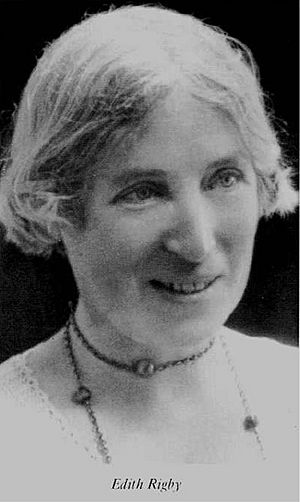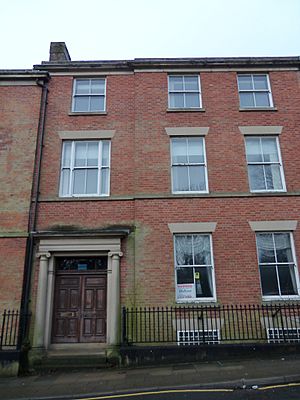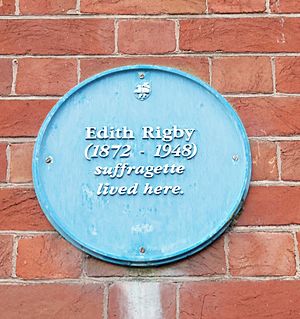Edith Rigby facts for kids
Quick facts for kids
Edith Rigby
|
|
|---|---|

Rigby in 1900
|
|
| Born | 18 October 1872 Preston, Lancashire, England
|
| Died | 23 July 1950 (aged 77) Llanrhos, Wales
|
| Education | Penrhos College |
| Political party | Labour Party |
| Spouse(s) | Charles Rigby |
| Children | 1 |
Edith Rigby (born Rayner) (18 October 1872 – 23 July 1950) was an English suffragette. Suffragettes were women who fought for the right to vote. Edith used strong methods, like setting fires, to help women gain this right.
She started a special night school in Preston called St Peter's School. This school helped women and girls get an education. Edith became a very active campaigner. She was put in prison seven times for her actions. She was a friend to other famous suffragettes like Christabel and Sylvia Pankhurst.
Edith Rigby's Early Life
Edith Rayner was born on October 18, 1872, in Preston, Lancashire. She was one of seven children. Her father was Dr. Alexander Clement Rayner. Edith went to school at Penrhos College in North Wales.
She later married Dr. Charles Rigby. They lived in Winckley Square in Preston. From a young age, Edith noticed big differences. She saw how working-class women lived compared to middle-class women. After she married, she worked hard to make life better for women and girls. Many of these girls worked in local mills.
In 1899, she opened St Peter's School. This school allowed working women to meet. They could continue their education there. Many girls had to stop school at age 11. Edith also treated her own servants differently. She let them eat in the dining room. They did not have to wear uniforms. This was unusual for the time.
Fighting for Women's Rights
In 1907, Edith started the Preston branch of the Women's Social and Political Union (WSPU). This group worked for women's voting rights. Edith was good at finding new members. She recruited people from the local Labour Party. One new member was Eleanor Higginson, who became a close friend.
In 1908, Edith marched to the Houses of Parliament in London. She marched with Christabel and Sylvia Pankhurst. Fifty-seven women, including Edith, were arrested. They were sent to prison for one month. During this time, Edith went on hunger strike. This meant she refused to eat. She was then force-fed by prison staff. She was imprisoned seven times in total.
Edith used strong ways to protest. On July 5, 1913, she placed a bomb in the Liverpool Corn Exchange. The court later said it caused "no great damage." Still, Edith was found guilty. She was sentenced to nine months in prison. She had to do hard labor.
The WSPU gave Edith a special medal. It was called the Hunger Strike Medal 'for Valour'. This showed her bravery.
Edith also said she set fire to a bungalow. This was the home of Sir William Lever. The fire happened on July 7, 1913. The house was near Rivington Pike. It held many valuable paintings. The damage cost a lot of money.
After the fire, Edith explained her actions. She said:
I want to ask Sir William Lever whether he thinks his property on Rivington Pike is more valuable as one of his superfluous houses occasionally opened to people, or as a beacon lighted to King and Country to see here are some intolerable grievances for women.
She meant that women's rights were more important than property.
Edith disagreed with the WSPU during World War I. The WSPU decided to stop campaigning for votes. Edith believed they should continue. So, she joined a different group. It was called the Independent Women's Social and Political Union. She started a branch of this group in Preston.
Edith's Later Years
According to a book called Champion Lancastrians, Edith was a pioneer. In 1888, she was the first woman in Preston to own a bicycle. During World War I, she bought a small house. It was called Marigold Cottage, near Preston. She used it to grow food for the war effort.
Edith had short hair and wore men's clothes. She grew fruits and vegetables. She also kept animals and bees. She followed the ideas of Rudolf Steiner. She had a happy marriage with her husband. He lived with her at the cottage. They adopted a son named Sandy. In the 1920s, Edith helped start a group. It was the Hutton and Howick Women's Institute. She became its president. Edith also became a vegetarian.
In 1926, Charles Rigby retired. The couple started building a new house. It was called Erdmuth. It was outside Llanrhos, North Wales. Charles died before it was finished. Edith moved there alone at the end of 1926.
She continued to follow Steiner's work. She started her own "Anthroposophical Circle." She even visited one of his schools in New York. Even when she was old, she lived a healthy life. She enjoyed bathing in the sea. She also liked fell walking and meditating early in the morning. She later developed Parkinson's disease. Edith Rigby died in 1950 at Erdmuth.
See also
 In Spanish: Edith Rigby para niños
In Spanish: Edith Rigby para niños



